-
Posts
679 -
Joined
-
Last visited
-
Days Won
2
Content Type
Profiles
Forums
Blogs
Gallery
Events
Store
Posts posted by Lukasz Gaszewski
-
-
Office of the President of the Soviet Union
Actors:
1. Mikhail Gorbachev (15 March 1990 - 25 December 1991) - on holidays

2. Gennady Yanayev's usurpation - drunk :cheers:
0 -
The two central ribbons in the first row are of the Order of the Red Banner of Labour.
The other ribbons, starting from row 6: Long Service Medal - 20 Years (USSR); Order Polonia Restituta (probably commander cross - Poland); Brotherhood in Arms Decoration (Poland)
row 7: Order of 9th September 1944 - 3rd Class (Bulgaria); Order (or Cross) of Bravery (Bulgaria); Medal for Merit to Bulgarian People's Army (Bulgaria); 20 Years of Bulgarian People's Army (Bulgaria)
row 8: 25 Years of Bulgarian People's Army (Bulgaria); ???; Brotherhood in Arms Medal (Bulgaria); Brotherhood in Arms Medal - gold (GDR)
row 9: Medal for Strngthening Brotherhood in Arms - gold and bronze (Czechoslovakia); ???
row 10: 30th Anniv. of Victory over Japan (Mongolia); 50 Years of People's Army (Mongolia); 30th anniversary of Victory at Khalkhin Gol (Mongolia); Friendship Medal (Mongolia)
row 11: 20th Anniversary of FAR (Cuba)
I agree the offficer must have been from the non-line service.
0 -
JimZ, perfect answer as ever !!!

The monument was designed by Otakar Švec, accompanied by by a couple of architects, Jíří and Vlasta Šturs. The work on the monument took more than five years (December 1949 - May 1955). The monument was unveiled on the 1st of May 1955. Švec himself did not survive until the unveiling - he committed suicide shortly before the ceremony. Probably because of that, his name was never revealed to public and it was was officially announced that the monument had been designed by... the whole Czechoslovak nation!
The monument itself was colossal. My data slightly differ from these JimZ has: 15 meters high (37 with the pedestal), 22 meters long and 12 meters wide. The figure of Stalin was followed by two rows of people: on the left (Soviet) side there was a worker, Soviet biologist Michurin, female cooperative worker and soldier; on the right (Czechoslovak) side: a worker, female farmer, writer and journalist Julius Fuičik and a Czechoslovak soldier.
The monument was destroyed in November 1962. The authorities ordered that is should be done "with maximum possible dignity" (!), filming, photographing or any other form of recording was forbidden.
The pedestal on which the monument was erected still exists; the area today is a well-known place for skaters.
Some other photos of the monument:

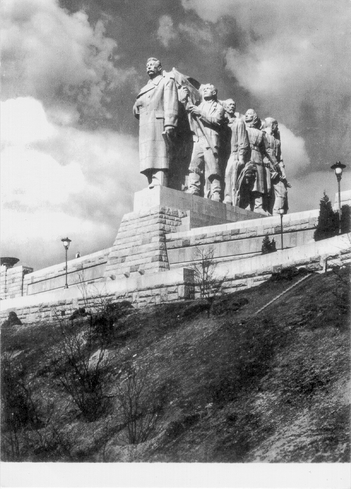
HAPPY NEW YEAR AND ONLY CORRECT ANSWERS IN 2012 !!!
 :beer:
:beer:  :beer:0
:beer:0 -
Question #111
1. Where (country and city) and when was the biggest monument of Stalin erected?
2. What happened to it later and when?
And two additional questions (you still win if you answer only the two questions above, it is only to give you the idea):
3. How high was it?
4. Who was the designer? (tricky!)
Good luck!
Lukasz
0 -
Ok, if no one else volunteers and the moderator gives his consent, I can ask the next question.
0 -
And a later issue (I think it is what Pisky is wearing) in the class of grand cross.
 0
0 -
Dear Thierry and All,
You are welcome, glad I could help

I am still intrigued by that commander cross, allegedly of the Hungarian Order of Merit. It has intrigued me for three reasons:
1. If Pisky was awarded with it, why wasn't it on the list of his honours?
2. If it is the Hungarian Order of Merit, it should be worn around the neck, above all foreign neck decorations.
3. The ribbon does not seem to be the correct Order of Merit ribbon.
I have decided to have another look at the photos and upon a closer examination I am sure that despite some resemblance, it is not the Hungarian Order of Merit at all! IMHO it is the commander cross of the General Bulak-Balachowicz Cross of Valour, an unofficial (not to say self-styled) decoration, awarded in Poland before WWII (for some reason one of the most sought decorations on collector market). It is possible that the mysterious Polish Partisan Order 2nd Class may refer just to this award.
What do you think?
0 -
Bonsoir,
A post-Christmas gift - do praise me and say "thank you" !!!

- Hungarian Order of Merit - Officer Cross (w. war decoration and swords)
- Hungarian Order of Merit - Knight Cross (w. war ribbon and swords)
- Hungarian Order of Merit - Knight Cross (w. war ribbon)
- [Austro-Hungarian] Cross of Military Merit 3rd Class
- [Austro-Hungarian] Silver Medal of Military Merit [signum Laudis] on the ribbon of the Cross of Military Merit [war ribbon]
- [Austro-Hungarian] Bronze Medal of Military Merit [signum Laudis] on the ribbon of the Cross of Military Merit [war ribbon]
- Hungarian Regent's Commendation Bronze Medal with Crown [so-called Hungarian Signum Laudis] w. a First World War miniature award
- Hungarian Red Cross, Cross of Merit
- Hungarian Regent's Commendation Bronze Medal w. Crown on green ribbon w. red and white edges
- [Austro-Hungarian] Silver Bravery Medal 1st Class
- [Austro-Hungarian] Silver Bravery Medal 2nd Class
- [Austro-Hungarian] Bronze Bravery Medal
- [Hungarian] Life Saving Medal
- [Austro-Hungarian] Charles Troops Cross
- [Hungarian] National Defence Cross
- [Austro-Hungarian] Wound Medal [on the ribbon] w. two stripes
- [Hungarian] War Comm. Medal w. swords and helmet
- [Hungarian] Officer Long Service Decoration 2nd Class
- [Austro-Hungarian] Red Cross Decoration 2nd Class w. war decoration
- [Hungarian] Upper Hungary Commemorative Medal
- [Hungarian] Transylvania Commemorative Medal
- [Austro-Hungarian] 1912/13 Jubilee Cross [Mobilization Cross]
- German Red Cross Decoration
- German [Prussian] Iron Cross 2nd Class
- German Order of the Eagle 2nd Class [Officer Cross]
- Belgian Red Cross, Cross of Merit 1st Class
- Bulgarian Order of Military Merit - Officer Cross 4th Class
- Croatian Order of the Crown of King Zvonimir 1st Class
- Italian Order of the Crown - Officer Cross
- Polish Order Polonia Restituta - Officer Cross
- Polish Partisan Order 2nd Class [????]
- [Hungarian] Vitézi Decoration
A nice collection indeed!
In brackets [ ] there are pats of the names which do not appear directly in the Hungarian names. The years do not necessarily correspond with the year when an decoration was actually awarded (see the Iron Cross) - I believe they are the years in which particular decorations were officially approved to be worn. Do not be surprised that Austro-Hungarian and Hungarian awards were all mixed up - old Austro-Hungarian decorations were considered an integral part of the Hungarian award system.
I think this list is stll incomplete. The photos depict Lieutenant Colonel Pisky with the Commander Cross of the Hungarian Order of Merit, which is not on the list. I think it could have been mistaken for the Officer Cross which should be worn as a pin decoration.
What regards the "Polish Partisan Order 2nd Class" I have no slightest idea what that could be. There was no award like that! Certainly not in 1939!!! Any ideas are welcome!
Lukasz :)
0 - Hungarian Order of Merit - Officer Cross (w. war decoration and swords)
-
I think this order has been awarded because he managed to avoid the destruction of the Silicon Valley...
Congratulations!!!
Had no idea the Sillicon Valley had been annexated by the Soviets
 Must watch the movie :D0
Must watch the movie :D0 -
Very good and quick answer Hauptmann
 Standartenführer Max Otto von Stierlitz (or Stirlitz, the name was originally spelled in Russian, so both types of German spelling can be found), a character created by writer Yulian Semyonov (1931-1993). I only wonder why this character has not come up on this forum before. Semyonov wrote as many as 12 books about colonel Isayev, among which the one entitled The Seventeen Instants of Spring (Семнадцать мгновений весны) was certainly the biggest success and was made a TV series in 1973, with the famous main role by Vyacheslav Tikhonov (1928-2009).
Standartenführer Max Otto von Stierlitz (or Stirlitz, the name was originally spelled in Russian, so both types of German spelling can be found), a character created by writer Yulian Semyonov (1931-1993). I only wonder why this character has not come up on this forum before. Semyonov wrote as many as 12 books about colonel Isayev, among which the one entitled The Seventeen Instants of Spring (Семнадцать мгновений весны) was certainly the biggest success and was made a TV series in 1973, with the famous main role by Vyacheslav Tikhonov (1928-2009).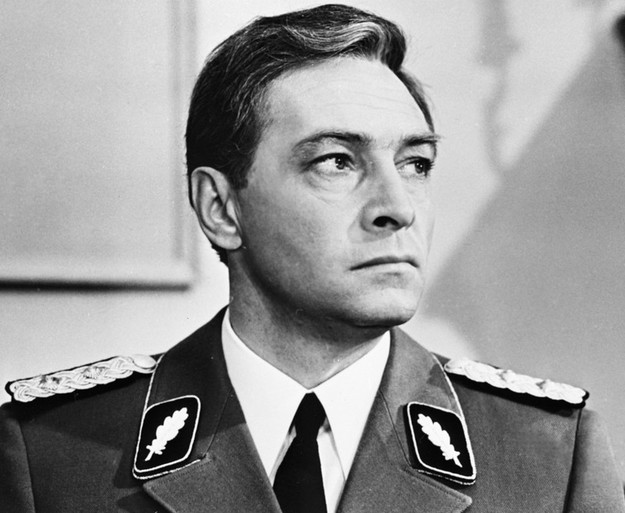
Vyacheslav Tikhonov as Standartenführer von Stierlitz
The plot takes place at the very end of WWII, during 17 days of February and March 1945. Von Stierlitz task is to disrupt peace negotiations between Himmler's man Karl Wolff and Allen Dulles taking place in Switzerland, aimed at forging a separate peace between Germany and the Western Allies. At the same time in a risky and bravoure operation Stierlitz saves the life of his radio operator Kät, who has been arrested by the Gestapo. At the end of the movie Stierlitz is informed he has been awarded the title of the Hero of the Soviet Union for the successful operation.
The Seventeen Instants of Spring TV series consists of 12 parts, each about 50 minutes long. The film is rather static, some scenes extremely long and overtalked, and about 1/4 of all scenes are historical chronicles of WWII (IMHO the movie could well be shortened to two two-hour parts, without much influence on the plot).
Despite all its weaknesses, the movie was a tremendous success and keeps being broadcasted in Russia again and again. I don't know how much truth there is in it, but it is said that Vladimir Putin decided to become a spy after watching The Seventeen Instants of Spring. In 2009 the originally black and white film was made a colour one (I saw it some time ago in colour on a Russian satellite channel).
An important part of the plot is "information to be considered" Stierlitz receives (and he can consider it for a long time sometimes). Probably this has led to a whole series of "Stierlitz jokes", a free interpretation of the movie's plot, very popular in both the USSR and Russia. Some of them are based on word play and are difficult to translate. A short one I like very much: "Stierlitz pondered. He found it attractive, so he pondered again."
The next question goes to Hauptmann! :cheers:
0 -
#109
Ok, it's my turn again... wow!

As it is still Christmas time, I would like my question not to be too difficult. I also hope my hero has not appeared in the quiz before (I have searched the topic and have not found anything about him). This is what my hero says about himself:
Although I am a fictional character, I was probably the most famous spy in service of my homeland - the Union of Soviet Socialist Republics. Every child in the Soviet Union knew me and my name has not perished even in the Russian Federation. And although I remained in secret service for a few decades, my most famous accomplishments dated back to the era of the Great Patriotic War. And now my questions:
1. Who am I?
I hope this will be easy
 , so to make it a bit more difficult, here are two additional questions:
, so to make it a bit more difficult, here are two additional questions:2. What is my real name?
3. What was my accomplishment as a spy during the Great Patriotic War for which I obtained the title of the Hero of the Soviet Union?
Good luck!!!
0 -
Lukasz,
Could you tell us how General received DSC?
According to my information, Poplawski received it in 1943, still as a Soviet Major General, from the hands of U.S. Ambassador in the U.S.S.R. The details of what exactly he received it for are unknown to me. As no Polish soldier ever received DSC, after being transferred to the Polish Army Poplawski was the only man in the Polish uniform to have this award.
Sorry for this small interruption.
0 -
Interesting. Viewing from the physical appearance of the medal, it looks very much like the official Russian Federation issue. Considering however that the inscription at the top is in Romanian, it can be the issue of the Pridnestrovian Moldavian Republic (PMR). Still, as I have not found it on the list of official PMR jubilee medals (there is only one medal commemorating the 60th anniversary of victory), I am not sure how much official the medal is.
Anyway, the words in Romanian read: "50 years from the day of victory in the great war in defence of the country, 1941-1945" and in Russian: "50 years of victory in the Great Patriotic War, 1941-1945."
Enjoy your Christmas time!!!
 0
0 -
Excellent answer ub6365!!!
 :jumping:
:jumping: 
Stanislaw Poplawski (this is how he is spelled in Polish) was born in Ukraine in 1902 in a Polish family. He was drafted to the Red Army in 1920, where he served first as a private, than as an NCO. in 1930s he became an officer and commanded a platoon and than a company. In February 1939 he was expelled from the army under false accusations and became a manager at a sovkhoz (still quite fortunate for him, as he could have been shot or sent to Siberia). After the German invasion of the Soviet Union he was first a member of the staff of the 162nd Rifle Division, next commander of 720th Rifle Regiment (July-September 1941), and then Chief of Staff of 363rd Rifle Division (October 1941-January 1942). During the next four months he commanded the 184th, 256th and 220th Rifle Divisions, and then the 45th Rifle Corps in the Soviet 5th Army (June 1943-September 1944).
In 1944 he was transferred to the Ludowe Wojsko Polskie (Polish People's Army) as one of the many Soviet officers. He commanded the Polish Second Army (26 September–19 December 1944) and later the Polish First Army (till 10 September 1945). His units took parts in the breakthrough of the Pommernstellung (Pomerania Wall) fortification line, securing the Baltic Sea coast, crossing the Odra and Elbe rivers and the battle of Berlin. He was wounded seven times in the war.
After the war he remained in the Polish army, along with thousands of other Soviet officers, and served as commander of the Polish forces occupying Germany, later being commander of the Silesian Military District (until 22 November 1947), Chief Commander of the Polish Land Forces (until 21 March 1950), and General Inspector of Military Training (until 2 April 1949). He also held political positions: on 2 April 1949 he became the 2nd Deputy Minister of National Defence and later was Deputy Minister himself. He was also a deputy to the Polish Sejm (1947-1956), and from 1949 to 1956 he was a member of the Central Committee of the Polish United Workers Party (PZPR). He was also the first four-star general (General of the Army) in the history of the Polish Armed Forces, which he became in 1955.
In 1956 he was commander of the military forces responsible for the suppression of the Poznań 1956 protests. Afterwards, together with a significant number of other Soviet officers, including Marshal Rokossovky himself, he left the Polish Army and returned to the Soviet Union, where he became the 1st Deputy of the Chief Inspector of Military Training of the Red Army, and from 1958 an advisor to the inspectors-general of the Soviet Ministry of Defense. He retired in 1963 with the rank of army general. He never came back to Poland. He died in Moscow in 1973.
The excellent photo of his you provided (I have never seen it before) must have been taken about 1950. It depicts Poplawski still as a three-star general, with an array of Polish (including the Commander Cross of Virtuti Militari), Soviet (including the star of the Hero of the Soviet Union), Czechoslovak and Yugoslav awards. His DSC is also seen very well (he is still wearing it, despite the fact it is the peak of the Cold War!). Note the seven stars for the wounds he sustained in the war (all while serving in the Red Army).
Here is another photo of his, as a General of the Army, taken in 1955, soon after he became a four-star general. He is wearing soviet-styled metal ribbon bars.
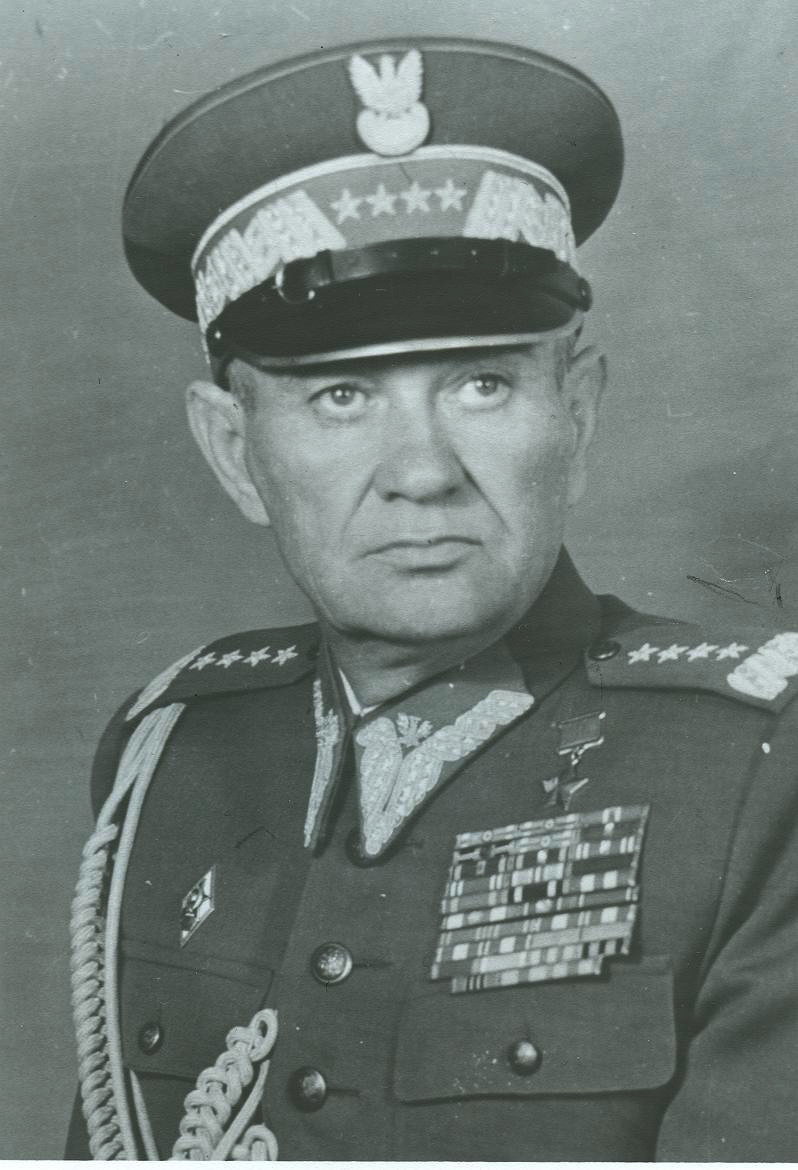
Congratulations again and now your turn for a question! :beer:
0 -
Hint #2:
I was also physically outstanding. I was always big and strong, and I was one of the tallest generals in the Polish Army. I was visible very well at military parades and other official celebrations.
0 -
I am sorry gentlemen, the guy is neither Gen. Baklanov, nor Gen. Sawicz. Gen. Sawicz, as Christophe said, was not "borrowed" from the Red Army but served in the Polish Armed Forces in the West (hence he would not qualify for this quiz). He was from the Air Force, not the Army and was appointed hon. Brig. Gen. as late as in 2006. Last but not least, as far as I know, he was never awarded the American DSC. Instead, he had both the British and the American Distinguished Flying Cross (and the Dutch Vliegerkruis). But I think it is of little difference for those fellows from the Warsaw Business Journal
 Do try again!0
Do try again!0 -
Although the Russian Army never officially introduced ribbon bars, some unofficial bars used to be worn. I normally do not collect Russian items, but this one came to me along with the some Polish ribbons. All used to belong to a Polish officer who had previously served in the Russian Army. Wearing imperial Russian medals was officially prohibited in the Polish Armed Forces, but some (mostly retired) soldiers sometimes wore it unofficially, along with other medals.
 0
0 -
I am really happy to be the winner!!!
 :jumping:
:jumping: 
And if it is my turn to ask a question...
 Err, I thought for some time and let it be this. Please read what my hero said and try to guess who he was:
Err, I thought for some time and let it be this. Please read what my hero said and try to guess who he was:I was one of many generals transferred or "borrowed" from the Red Army to the Polish "People's" Armed Forces (although the Polish Army was never officially called that!). But in some ways I was outstanding too. As this forum is dedicated to orders and medals, let this be the first hint: like all Soviet-originated generals I loved orders and medals and had a handful of them: Soviet medals, Polish medals, Czechoslovak medals and Yugoslav medals. But few people know that I was probably the only member of the Polish Forces ever, awarded with the American Distinguished Service Cross! (do not try to look it up at Wiki, as you are likely not to find anything about it there
 ). I was proud to have the highest U.S. COMBAT award available to a foreign military and I continued to wear it even during the Cold War.
). I was proud to have the highest U.S. COMBAT award available to a foreign military and I continued to wear it even during the Cold War.Who am I?
0 -
Are you by chance a diamond named Orlov, dwelling in the Diamond Fund in the Kremlin?
0 -
Five relatively new (established 2007) Polish commemorative stars, conferred for participation in missions in designated areas.

L. to r.: Afghanistan Star (2007), Iraq Star (2007), Chad Star (2010), Congo Star (2010), Mediterranean Star (2010).
Each star has a ribbon in a distinctive colour with edges in the colours of the country of the mission. In the centre there is always a red stripe, flanked by narrower stripes of white.
Ribbons for further possible missions will follow this pattern.
A sixth star for missions in former Yugoslava had also been planned but the idea was eventually turned down. Certainly a big loss to all who had served there.
0 -
On the uniform there was an impressive set of medals that belonged to the prince. Please note two Crosses of Military Merit (one with swords and Kriegsdekoration, the other without them).

Please enjoy identifying the medals on your own. One medal I cannot identify is the one between the Hindenburg Cross and the Hungarian War Medal for WWI. Can somebody help?
Another interesting thing about the Castle at Nachod is a collection of orders and decorations, said to be an impressive one. Unfortunately, the collection is open to public only in the first weekend of every month, and I was not able to see it, and the castle is closed from November to April. So if you are planning to visit the castle, remember to do it during the first weekend of the month, from May to October.
0 -
In October I had an opportunity to visit the castle at Nachod in the north of the Czech Republic. The castle belonged to the princely family of Schaumburg-Lippe until 1945.

Among many exhibits there were some uniforms worn by members of the Shaumburg-Lippe family. One of them, of a Major-General of Hussars, that used to be worn by prince Friedrich zu Schaumburg-Lippe, seemed particularly interesting. I hesitated whether to put this topic here or in the German section - I decided to put it here, as prince Friedrich was an officer in the k.u.k. cavalry.
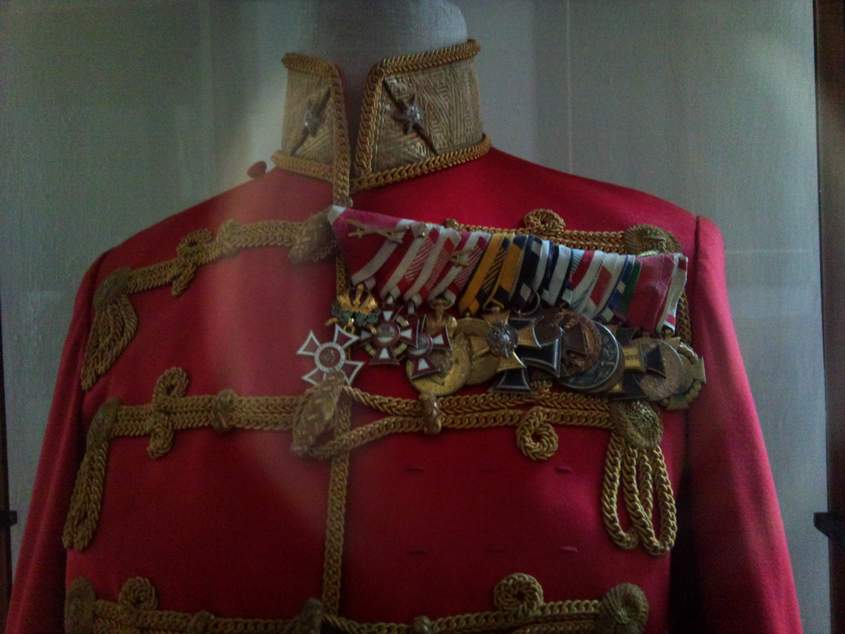
Friedrich Prinz zu zu Schaumburg-Lippe (1868-1945)
Upon graduation of the Maria-Therezia Military Academy in Wiener Neustadt in 1888 he commenced military service, first in the 5th Hussar Regiment of Marshal Radetzky and then in the 9th Hussar Regiment in Sopron, Hungary.
His military career, according to what was written next to the uniform was as follows:
1896 - Captain (Rittmeister)
1906 - Major
1910 - Lieutenant Colonel
1913 - Colonel
1916 - Major General
0 -
JDM has asked me to publish on his behalf the following entry to this topic, regarding the orders of the state of Terengganu - one of the least known of all Malaysian states. Doing this I would like to thank John for the information he has kindly shared with us on this forum.
Dear GMIC,
Forgive me as I cannot remember how to reply to any questions ect, I am
getting on at nearly 68.
I looked at your Terengganu section today, & as I have just bought some
Ribbons,
I attach them in a scan, they come from the "Sid Wood Collection"
& are all Terengganu:
1. Sultan's 100mm Sash S.S.M.Z.
2. Other ribbons marked S.S.M.Z. (100mm, Ladies Sash = 60mm,
D.Z.M.T. = 90mm, Ladies = 60mm, D.Z.M.Z. = 48mm, then 38mm, & 32mm)
3. The blue/green/yellow/green/blue 90mm sash marked D.K.R.I. (which is not
known to me).
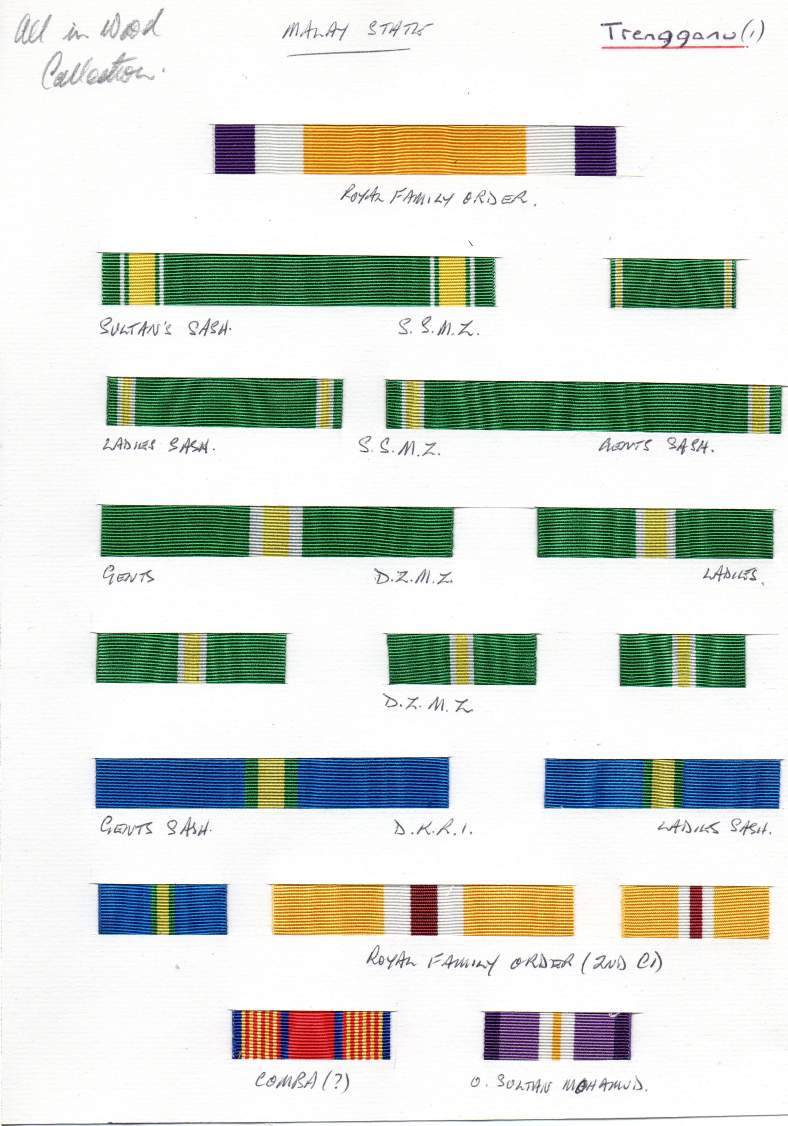
I can add from myself that the left ribbon in the last row belongs to the Bintang Jasa Bomba (Meritorious Service Star) of the Fire and Rescue (Bomba dan Penyelamat) Malaysia.
0 -
I agree too that the 'X' denotes the de-utilization of the royal cypher and the cross may come from the transitional period (1946-47). The plain blue ribbon is kind of proof too, although not very strong (it is not difficult to substitute one ribbon for another).
BTW, does anybody has information if the "merito di guerra" type cross was ever awarded with a sword on the ribbon? I have a cross inscribed "merito di guerra", however the ribbon (blue with white stripes) has a bronze Roman gladio, which as far as I know was used with the "al valore militare" type only. I suppose that the gladio could be pinned in later, just to add more splendour to the more common cross.
0



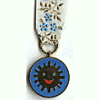
Modest Soviet Ribbon Bar - 39 awards!
in Russia: Soviet Orders, Medals & Decorations
Posted
10 points for you Vlad! It is very likely, particularly that the red ribbons belong to the Bulgarian and Czechoslovak groups respectively. Another peculiarity of this bar is that the ribbon order in the "Mongolian" row is ideally (!) reversed.